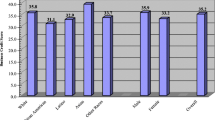Abstract
Earlier research exploring rural bank entry decisions suggests that market size and its growth seem to be major explanatory factors. In addition, the role of leading bank holding companies is found to be important in stimulating entry of smaller rivals. This article finds that credit union entry responds in a similar way, and in addition that the state-level financial regulatory climate matters. An ordered-probit analysis of credit union numbers yields the intuitive result that credit unions possess little market power (even in rural markets where they might be expected to play a significant role), and what little there is can likely be eliminated by a third credit union in the market.
Similar content being viewed by others
References
Amel D.F., Hannan T.H. (2000) Defining banking markets according to the principles recommended in the Merger Guidelines. Antitrust Bulletin 45: 615–639
Amel D.F., Liang J.N. (1997) Determinants of entry and profits in local banking markets. Review of Industrial Organization 12: 59–78
Berger A.N., Bonime S.D., Goldberg L.G., White L.J. (2004) The dynamics of market entry: The effects of mergers and acquisitions on entry in the banking industry. Journal of Business 77: 797–832
Berger A.N., Dick A.A. (2007) Entry into banking markets and the early-mover advantage. Journal of Money, Credit and Banking 39: 775–807
Berger A.N., Dick A.A., Goldberg L.G., White L.J. (2007) Competition from large, multimarket firms and the performance of small, single-market firms: Evidence from the banking industry. Journal of Money, Credit and Banking 39: 331–368
Berger, A. N., Kashyap, A. K., & Scalise, J. M. (1995). The transformation of the U.S. banking industry: What a long, strange trip it’s been. Brookings Papers on Economic Activity 55–218.
Bresnahan T.F., Reiss P.C. (1991) Entry and competition in concentrated markets. Journal of Political Economy 99: 977–1009
Cetorelli N. (2002) Entry and competition in highly concentrated banking markets. Economic Perspectives 26: 18–27
Cohen A.M., Mazzeo M.J. (2007a) Market structure and competition among retail depository institutions. Review of Economics and Statistics 89: 60–74
Cohen, A. M., & Mazzeo, M. J. (2007b). Investment strategies and market structure: An empirical analysis of bank branching decisions. Working Paper, Federal Reserve Board.
Dick A.A. (2007b) Market size, service quality and competition in banking. Journal of Money, Credit and Banking 39: 49–81
Feinberg R.M. (2001) The competitive role of credit unions in small local financial services markets. Review of Economics and Statistics 83: 560–563
Feinberg R.M. (2002) Credit unions: Fringe suppliers or Cournot competitors? Review of Industrial Organization 20(105–113): 20, 105–113
Feinberg, R. M. (2007). Patterns and determinants of entry in rural county banking markets. Journal of Industry, Competition, and Trade (in press). doi:10.1007/s10842-007-0015-9.
Feinberg R.M., Kelly W.A. Jr. (2003) Less-restricted fields of membership for credit unions: Public policy implications. Filene Research Institute, Madison, WI
Hannan T.H. (2005) Retail deposits by banks and thrift institutions: Evidence from urban and rural markets. In: Klein E. (eds) Global banking issues. Nova, Hauppauge, NY, pp 75–99
Keeton W.R. (2000) Are mergers responsible for the surge in new bank charters?. Federal Reserve Bank of Kansas City Economic Review 85: 21–41
Pilloff S.J. (1999) Does the presence of big banks influence competition in local markets?. Journal of Financial Services Research 15: 159–177
Seelig, S. A., & Critchfield, T. (2003). Merger activity as a determinant of de novo entry into urban banking markets. FDIC Working Paper 03-1.
Tokle R.J., Tokle J.G. (2000) The influence of credit union and savings and loan competition on bank deposit rates in Idaho and Montana. Review of Industrial Organization 17: 427–438
Toivanen O., Waterson M. (2005) Market structure and entry: Where’s the beef?. Rand Journal of Economics 36: 680–699
Author information
Authors and Affiliations
Corresponding author
Rights and permissions
About this article
Cite this article
Feinberg, R.M. Explaining the Credit Union Entry Decision, and Implications for Performance. Rev Ind Organ 33, 81–91 (2008). https://doi.org/10.1007/s11151-008-9177-9
Published:
Issue Date:
DOI: https://doi.org/10.1007/s11151-008-9177-9




